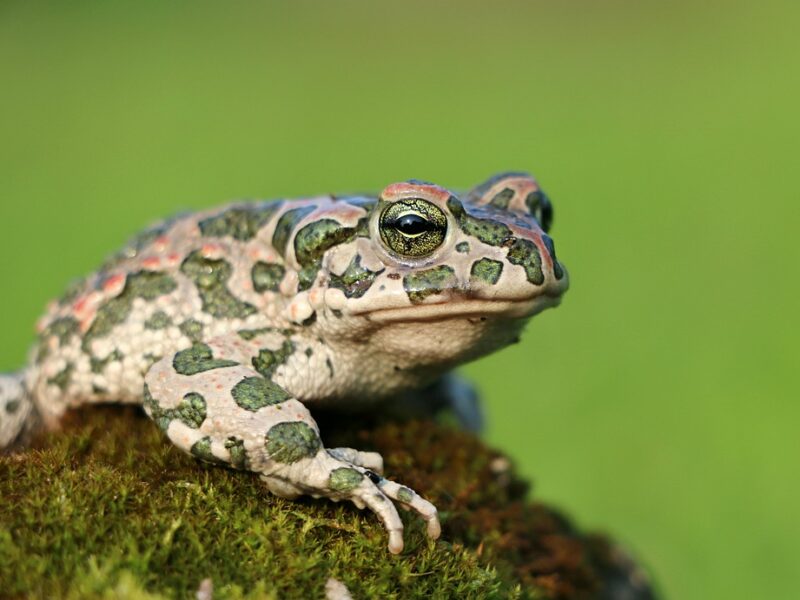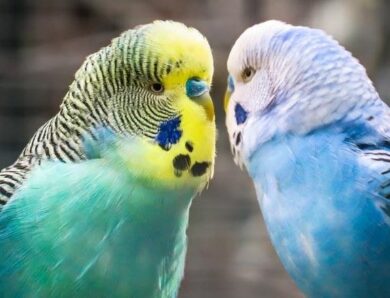
Reproduction of different species of frogs, how amphibian amphibians reproduce
Frogs can reproduce, when they reach the age of four. Waking up after hibernation, adult amphibians are immediately sent to spawning grounds, where there is a search for a suitable partner. The male has to perform different types of tricks in front of the female, to get her attention, such as songs and dances, do their best to show off. After the female chooses a suitor, which she liked, they begin to look for a place to lay eggs and fertilize them.
mating games
voice
Most male frogs and toads attract females of their species by voice, namely croaking, which is different in different species: in one species it looks like a "trill" of a cricket, and in another - on the usual "kva-kva". You can easily find the voices of males on the Internet. The loud voice on the pond belongs to the males, and in females the voice is very quiet or absent altogether.
courtship
- Appearance and color.
Males of many species of frogs, example, tropical woodpeckers, change their color during marriage, become black. In males, unlike females, eyes are big, better developed senses and enlarged brain, respectively, and the front paws are decorated with so-called marital calluses, which are necessary for mating, so that the chosen one could not escape.
- dance
The attention of females can be attracted by various movements. Colostethus trinitatis just rhythmically bounce on a branch, and Colostethus palmatus become in exquisite poses, seeing a female on the horizon, and other species, living near waterfalls, manage to wave females paws.
Males of Colostethus collaris perform a dance during courtship. The male crawls up to the female and crows louder and faster, then crawls away, swings and jumps, while freezing on the hind legs in a vertical position. If the female is not impressed by the idea, she raises her head, showing his bright yellow throat, it discourages the male. If the males liked the male dance, then she watches a beautiful dance, crawling to different places, to better see the game of the male.
Sometimes a large audience can gather: once scientists, observing Colostethus collaris, counted eighteen females, who stared at one male and synchronously moved to another position. He danced, the male goes slowly, it often rotates, to make sure, that the lady of the heart follows him.
The golden woodpeckers, vice versa, females fight for males. Finding a male, who kumka, the female slaps her hind legs on his body and puts her front paws on him, can also rub his head against the male's chin. The male with less passion corresponds to the same, but not always. Many cases have been reported, when in this species of amphibians there were fights as between females, and males for a favorite partner.
Fertilization or how frogs reproduce
Fertilization, what happens outside
This type of fertilization is most common in frogs. The smaller male firmly embraces the female with his front paws and fertilizes the female to sweep the eggs. The male embraces the female in the amplex pose, which comes in three options.
- Behind the forepaws of the female, the male produces a girth (sharp-nosed frogs)
- The male embraces the female in front of the hind limbs (scaphiopuses, garlic)
- There is a girth of the female around the neck (trees).
Fertilization, what's going on inside
Few tree climbers (example, Dendrobates granuliferus, Dendrobates auratus), fertilized in another way: the female and the male turn their heads in opposite directions and connect the cloaca. In the same position, fertilization occurs in amphibians of the species Nectophrynoides, which first spawn, and then tadpoles in utero until the process of metamorphosis and give birth to fully formed frogs.
In tailed male frogs of the genus Ascaphus truei, there is a specific organ for reproduction.
During the breeding season in males often on the front paws are formed specific mating rough calluses. With these calluses, the male stays on the slippery body of the female. An interesting fact: example, in the common frog (Bufo bufo), the male climbs on the female far from the pond and rides on it a few hundred meters. And some males can ride a male after the mating process is complete, waiting, until the female forms a nest and lays eggs in it.
If the mating process takes place in water, the male can keep the eggs swept by the female, pushing hind legs, to have time to fertilize the eggs (вид — Bufo boreas). Quite often males can confuse and climb on males, who clearly do not like it. "Victim" reproduces the specific sound and vibration of the torso, namely the back, and makes you get off yourself. Females also behave at the end of the fertilization process, although sometimes the male can release the female himself, when he feels, that her stomach became soft and empty. Quite often females actively shake off males, who are lazy to get off, turning to the side and pulling the hind limbs.
Combination - amplex
see amplex
Frogs lay eggs, like fish, since in caviar (eggs) and embryos lack adaptation for development on land (anamnesis). Different species of amphibians lay eggs in amazing places:
-
in nori, the slope of which goes into the water. When the tadpole hatches, then he slips into the water, where its further development takes place;
- the female with the collected mucus from the skin forms nests or lumps, then attaches the nest to the sheets, hanging over the pond;
- some wrap each egg in a separate leaf of a tree or reed, hanging over the water;
- female Hylambates brevirostris generally lays eggs in its mouth. Males of Darwin's rhinoderma have special sacs in their throats, where they lay eggs laid by the female;
- in arid areas live short-toed frogs, which lay eggs in raw soil, where the tadpole then develops, and the formed amphibian is already crawling to land;
- females of the genus Pipa carry eggs on themselves. After fertilization, the male pushes them into the back of the female with his belly, stacking eggs in rows. Eggs, which stuck to plants or to the bottom of the pond, cannot develop and die. They survive only on the backs of females. A couple of hours after laying in females on the back of a porous gray mass, in which caviar is sunk, then the female sheds;
- some species of females from their own mucus form annular shafts;
- in some species of frogs in the folds of the skin on the back formed a so-called brood bag, where the amphibian lays eggs;
- some Australian species of frogs hatch eggs and tadpoles in the stomach. For the period of gestation in the stomach with prostaglandin disables the function of the formation of gastric juice.
For the entire period of tadpoles, and it lasts two months, the frog does not eat anything, while maintaining activity. During this period, it uses only the internal reserves of glycogen and fat, which is stored in her liver. After the process of hatching in frogs, the liver is reduced in size three times and no fat remains on the abdomen under the skin.
After laying eggs, most females leave their clutch, as well as spawning waters, and go to their usual places of residence.
Eggs are usually females surrounded by a large layer of gelatinous substance. The shell for the eggs plays a big role, since the egg is protected from drying out, from damage, and most importantly - it protects it from being eaten by predators.
After procrastination, after a while, the shell of the eggs swells and forms a transparent gelatinous layer, inside which the egg is viewed. The upper half of the egg is dark, and the lower, on the contrary, light. The dark part heats up more, as it uses the sun's rays more efficiently. In many species of amphibians, caviar clumps float to the surface of the pond, where the water is much warmer.
Low water temperature delays the development of the embryo. If the weather is warm, the egg divides repeatedly and is formed into a multicellular embryo. Two weeks later, a tadpole emerges from the egg - a frog larva.
Tadpole and its development
After hatching, the tadpole falls into the water. Already through 5 days, having spent the supply of nutrients eggs, he will be able to swim and eat on his own. He forms a mouth, has horny jaws. Tadpoles feed on the simplest algae and other aquatic microorganisms.
By this time, the tadpoles already have a visible body, head, tail.
The tadpole's head is large, missing limbs, the tail end of the torso plays the role of a swimmer, a lateral line is also observed, and near the mouth is a suction cup (on a sucker it is possible to identify a sort of a tadpole). Two days later, the slit at the edges of the mouth becomes overgrown with a kind of bird's beak, which performs the function of pliers, when the tadpole produces feeding. Tadpoles have gills with gill holes. At the beginning of development they are external, but in the process of development are modified and attached to the gill arches, located in the pharynx, at the same time function already as usual internal gills. The tadpole has a two-chambered heart and one circulatory system.
According to the anatomy of tadpoles at the beginning of development is close to fish, and growing up, it already bears a resemblance to a species of reptile.
After two or three months, the tadpoles grow back, and then the front paws, and the tail first shortens, and then disappears. Lungs also develop. Formed to breathe on land, tadpole begins its rise to the surface of the pond, to swallow air. Changes and growth depend largely on hot weather.
Tadpoles initially feed mainly on food of plant origin, but then gradually switch to animal food. The formed frog can be selected ashore, if it is a terrestrial species, or continue to live in water, if it is an aquatic species. The frogs that went ashore are young. Amphibians, laying eggs on land, sometimes proceed to development without the process of metamorphosis, that is, through direct development. The development process takes about two to three months, from the beginning of egg laying to the end of tadpole development into a full-fledged frog.
Amphibians-woodpeckers show interesting behavior. After the tadpoles hatch from the eggs, female on her back, one by one transfers them to the tops of trees in flower buds, in which water accumulates after rain. This kind of pool is a good children's room, where children continue to grow. Unfertilized eggs serve as food for them.
The ability to reproduce in cubs is reached around the third year of life.
After the breeding process, green frogs remain in the water or stay on the shore near the pond, while storms go ashore from the reservoir. The behavior of amphibians is largely determined by humidity. In hot dry weather, brown frogs are mostly inconspicuous, as they hide from the sun's rays. But after sunset it is time for them to hunt. Because the green species of frog lives in or near water, then they hunt in daylight.
With the onset of the cold season, brown frogs move to the pond. When the water temperature rises above the air temperature, brown and green frogs dive to the bottom of the pond for the entire period of winter cold.




